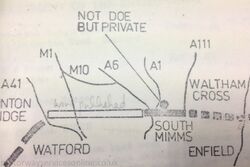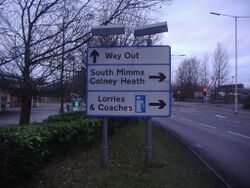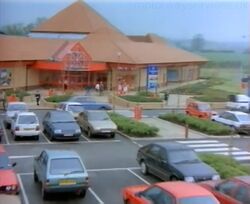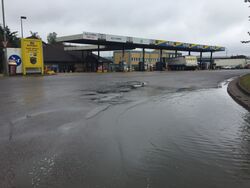History of South Mimms services

A 1975 map of services planned for the M25 makes the first acknowledgement of Bignell's Corner.

There have been two main amenity buildings at South Mimms - but there was also a much older complex which pre-dates the motorway network. This is the history of the services.
Bignell's Corner

Bignell's Corner is the name given to the area immediately surrounding South Mimms services. It is the official name of the M25/A1 roundabout, though the junction is better known as 'South Mimms Interchange'.
The name (and the service area) date back to the pre-motorway era, where the A1 Barnet By-Pass and the A6 St Albans Road met at a busy triangle-shaped junction, which is where the St Albans Road roundabout is now. Scattered around the junction were two pubs, a garage, a garden centre named Bignell's (hence the junction's name), a motel and a truckstop.
The truckstop was known as the Beacon Café, and was popular with lorry drivers heading in and out of London and also infamous for its use by prostitutes. The motel was built in 1966 as an Esso Motor Hotel, which became Crest Hotels. Everything to the west of the road, including the pubs and the garage, closed in the 1970s to make way for the new A1(M). [view a map from the time]
Slightly to the south, the modern interchange was built in the early 1970s, but it originally served the realigned A1 and A6/A1178, plus two local roads, one of which looped past the truckstop and on to the village of South Mimms. The truckstop would be owned by Deards, and promoted as 'Beacon Services'. There were also fragments of the old St Albans Road, chopped up by the motorway, still serving Charleston Paddocks.
Glasgow's Daily Record highlighted the facilities as a potential place to stop on the then-incomplete M25 in July 1984. At the time they said it consisted of a hotel with food, coffee and toilets next to two petrol stations.
Upgrading
See also: M25 Service Area Planning
By the early 1980s, part of the A1 had been upgraded to motorway and the A6 and A1178 had been unexpectedly changed to form part of the M25. The new roundabout had been enlarged and was gaining flyovers.
Meanwhile, a study into service areas on this newly-rerouted M25 was underway. This study started at Sevenoaks and worked its way clockwise, suggesting service areas be built at Leatherhead and Colnbrook. These were engulfed by planning difficulties, and with the rest of the planning depending on knowing where those service areas would be, it was decided to leave the rest of the road for now.
Aware that this strategy could backfire, the Department of Environment did at least note that there were already facilities at Bignell's Corner. At the time, all motorway services were owned by the DOE, but this unusual "privately owned" collection of facilities was first formally acknowledged as a potential part of the M25 project in 1975.
In 1984 it was confirmed that South Mimms would join Thurrock and Clacket Lane as the M25's service areas. A motorway maintenance depot was set up here too. The complex was billed as "the biggest motorway service area in Europe". This was a big change for an area that didn't know it was going to be on the London Orbital route until a few years previously, but it was perhaps better than building on completely green land.
Opening and Branding
The Guardian, 1989
BP's enthusiasm for building a service area here made it the first in the country to be classed as a "private initiative", where the private sector did most of the legwork. The Department of Transport then acquired the site, and leased it back to BP on a 125 year agreement - the longest service area lease in the UK. The Department of Transport said they followed this process to take advantage of BP already owning most of the land, saving them time.
A refurbished 26-pump filling station opened in December 1986, two months after the M25 was joined up. It was expected to become one of the busiest in Britain. The main building opened on 24 May 1987, making South Mimms the first service area on the M25. An official opening ceremony was held on 6 June 1987, attended by Prime Minister Margaret Thatcher, who had famously cut the ribbon on the motorway.
BP chose to the lease the main amenity building (designed for cars and coaches) to Hanson's Welcome Break. In 1986, Welcome Break was taken over by Trusthouse Forte, who decided to brand it up as one of their own service areas. The outside of the building was compared to a supermarket: it was a brick building with a pyramid-shaped roof, and red frames around the glass doorway. A tiny example of this light brickwork remains in the delivery bay.
Inside, it was compared to an airport lounge: it had a low ceiling, a marble floor and twee globe-shaped lamps. There was a 426-seater The Granary restaurant decorated with fake palm trees, Julie's Pantry, a take-away restaurant (later Caffe Primo) and two meeting rooms which boasted photocopying machines, fax machines and a mobile telephone; these facilities were meant to entice businessmen who had been left out of most other service areas. A Sweet Delights counter was soon added, along with a Book Shop.
It had 700 car parking spaces, and cost £7million to build (around £20million in 2025), with the complex being built over surrounding fields, Five Bells Farm and the garden centre. 250 jobs were initially created. With 250 jobs created, Forte ran recruitment campaigns across the country with the message, "move south to one of the best working environments around".
Less than a year after Forte had decided to brand South Mimms under their own name, they then decided to change all Trusthouse Forte service areas to Welcome Break. A Little Chef was added, as well as a drugstore and a bureau de change. The main restaurant had a counter service which issued numbers, so that the food could be cooked to order.
Operation

Lord Forte attended a launch event for the new Welcome Break brand at the service area on 19 May 1988.
Concern was raised by the Department of Transport's Road Construction Unit in 1989 that the roundabout outside South Mimms was turning into an "acute problem". It was already severely overloaded, and they felt this would only be solved by building two new flyovers. That would in turn direct traffic away from the service area, which could have prompted a significant request for compensation.
Widening the A1(M) soon became government policy, and while no detail was given, inspectors warned that there would be a "severe impact" on the service area. In the event the decision was taken to keep squeezing more capacity out of the existing roundabout, so there was no case for compensation.
Despite the threat, a new Travelodge was built in late 1990. This would become Welcome Lodge, Days Inn and then Ramada.
A 1994 study found that the M25 here was the busiest motorway in England to have a service area. It may no longer be in the top spot, but it will still be a lucrative location.
During the 2021 fuel crisis, the queues to buy fuel at South Mimms caused a lot of disruption to local residents, who rely on the roads around South Mimms to go about their business. Given its prominent location and its reputation for staying open, South Mimms became one of the UK's busiest places, with severe queues at all times of the day and night, except for the periods where it had run out.
The main petrol station (for cars) continues to be on land owned by the authorities - now National Highways - which is leased to BP.
Truckstop Issues

Signs at the exit from the main roundabout split traffic into "car services" and "lorry services", as they still do today. The lorry services were owned by the government and leased to Deards, the existing truckstop business.
Shortly after the main service area officially opened, the old truckstop that had been expected to provide all the HGV facilities closed. An investigation in September 1987 found that Forte were preventing HGV drivers from accessing the main building, although Forte denied this. The same investigation described the area which HGVs were expected to use as "unmarked, unlit, not signposted, and very cramped", with a café that was "abandoned" and "dilapidated".
This situation caused considerable tension between Forte and HGV drivers, with the Transport and General Workers Union almost arranging a boycott of all Forte facilities. The problem appeared to be that HGV drivers weren't banned as such, but they were directed out of sight to a position where they couldn't walk to the main facilities even if they wanted to. Some HGVs were parking in the coach park and refusing to move.
In November 1987, BP announced that they were involved in "tripartite discussions" regarding the abandoned truckstop. It reopened as a BP Truckstop in 1989. A sign at the entrance had 18 lights to show drivers which lanes they could fuel up at.
The BP Truckstop received mostly positive feedback, but BP ended their dedicated truckstop chain in 2002. In the months that followed, its reputation collapsed, with surveys suggesting it was the worst truckstop in Britain. Welcome Break took over and spent £90,000 refurbishing it (now worth around £142,257 in 2025). Welcome Break did not provide it with much internal branding or publicity, instead relying on the existing signage; a keen eye was needed to spot any use of their company colours.
Special "South Mimms Truckstop" branding was finally introduced in 2012. A large, yellow sign at the entrance encouraged drives to "fill up & chill out". The conversion of the forecourt to Welcome Break branding in 2024 finally made it clear who was running it.
Old Reviews
In early 2024, Transport Focus calculated a 92% satisfaction store among truckstop customers, placing it in the top quarter.
The 2023 Transport Focus assessment gave the main service area a 96% satisfaction score. This was up from 95% in 2022.
In 2021, Which Magazine ranked South Mimms 56th out of the 68 service areas they visited.
The 2019 Transport Focus assessment called it the fifth-best service area on the network, with a 99% satisfaction score, up from a more average 95% in 2018 and 96% in 2017.
A 1995 review in The Independent gave the service area three stars, calling it "modern and pleasant".
A 1994 study found that the service area was 1.78x more popular with traffic trying to travel east along the M25, than that trying to travel west, as a consequence of the layout of the roundabout.
In 1991, a Which? survey recommended the service area.
Egon Ronay praised the service area in his 1990 guide, saying it had a "most striking interior design".
In 1989 the Landscape Advisory Committee described the service area as "first class", a rare honour. Also that year, it was a runner up in the Auto Express survey.
In 1988, Commercial Motor Magazine complained about the restaurant being expensive and slow, reporting that one driver had been waiting 90 minutes.
Changes
Trusthouse Forte, 1986
The on-site motel was built in 1990. Government policy ought not to have allowed it to be built because the land was prioritised to expand the services, but as there was no nearby suitable place for a hotel, it was decided to allow it. Meanwhile, the historic, existing motel survived the changes and went on to become a Premier Inn.
A large fire broke out on the morning of 13 August 1998, which was caused by an unattended frying pan in Julie's Pantry. Every full-time fire crew in South Hertfordshire was needed to fight the blaze, which damaged 80% of the amenity building.
The forecourt reopened later that day, while temporary toilets opened in the car park a week later. A more substantial temporary building with a 350-seat restaurant, coffee shop and shop was setup within a few weeks; once it was no longer needed, this building was sold in an online auction.
The replacement (1999) service area building originally housed a mixture of free-flow sit-down catering and coffee shop/fast food space. It was overhauled to become entirely fast food-based in 2014. A new building was built next door to host a trial Ed's Easy Diner, which wanted custom from family day-trips. It closed after two years and replaced by PizzaExpress.
Within the food court, another brand to be trialled inside was Pret A Manger.